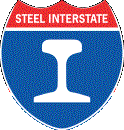Steel Interstate Newsletter
Vol. 1, No. 4
November 1, 2016
Welcome to the new RAIL Solution railroad industry update. In this periodic communication we attempt to keep you informed of key developments and place our Steel Interstate advocacy in context. The Newsletter is also attached as a PDF to facilitate downloading and reviewing on a wider variety of electronic devices.
Prior issues and other creative materials are available on this website in the form of other posts of newsletters. Download this newsletter in PDF format. Steel-Interstate-Newsletter- 11-1-16
IN THIS ISSUE:
============
- Our Rail Advocacy is NOT Anti-Truck
by David Foster, RAIL Solution Executive Director
- Remembering Jim McClellan – A Rail Guru Gone
by Ken Marsh, RAIL Solution Chairman & David Foster
- A Note on Infrastructure
- A Note on Donations
Our Rail Advocacy is NOT Anti-Truck
Today much mid- to long-distance freight moves by truck over the road, consuming over three times the energy (and producing three times the pollution) required to move that same freight by rail. And rail’s advantage in energy conservation can double with railroad electrification.
As discussed in our September issue, billions of dollars are pouring into autonomous vehicle technology. Proponents envisage “platoons” of self-driving trucks as the future transportation paradigm in this country. Driver or no, all these trucks still have to be powered over the road individually. Public policies need to consider the economic and environmental consequences of such a plan. In addition to increased dependence on fossil fuels, the autonomous trucking approach could well require construction of an environmentally destructive new tier of truck-only highways.
Trucking is vital. Almost all freight movements, except unit train rail shipments, need to originate and terminate by truck. It is simply impossible to provide rail access directly to every factory, farm, and warehouse. But environmental and energy considerations support moving as much mid- to long-distance freight by rail as possible.
Putting through trucks on trains solves this problem and allows each mode to do what it does best. As long as such truck ferry operations are structured to provide three key elements, highway-competitive speed, reliability, and cost, they would benefit railroads, truckers, and the public.
Railroads would tap into a vast new market of highway goods movement. Truckers would achieve a big productivity boost by having their trucks continue to move during mandated driver rest periods. And the public would see fewer trucks clogging the interstates and need to spend far less on highway maintenance and construction.
Currently rail industry capacity is lacking to support a truck-ferry operation in a major freight corridor reliably. Delays resulting from trains meeting one another, as well as other conventional freight traffic, on single-track rail lines would be intolerable. So at a minimum a double-track railroad is required.
Capacity is a primary focus of our Steel Interstate advocacy. Mainline rail routes need to be able to handle all kinds of trains with minimal interference and maximum reliability. The Steel Interstate would be a core national network of high-capacity, grade-separated, electrified railroad mainlines, comprising the backbone for movement of both people and goods in the 21st Century.
Remembering Jim McClellan – A Rail Guru Gone
Jim McClellen died unexpectedly in October, succumbing to injuries sustained in a fall. Jim was one of the most widely quoted rail industry representatives. Any time a major industry story broke, writers would seek out Jim for his typically insightful comments, supportive or critical. He was also a fixture at many rail industry conferences and events, typically immersed in a group discussing some element of current industry relevance.
Jim’s storied career with New York Central, the U.S. Railroad Administration, Conrail, Southern Railway, and Norfolk Southern was chronicled in Rush Loving’s 2013 book, The Men Who Loved Trains.
Preparatory to the Norfolk Southern merger in 1982, David Foster recalls working on a traffic diversion study where he was a Norfolk & Western representative on the committee and Jim represented Southern. In those days the Interstate Commerce Commission required a statistical sample be taken of all waybills from the two railroads and the traffic analyzed to determine the impact of the merged carrier. The work was long and tedious, but even then Jim’s wit and knowledge made him a joy to work with.
Long time friend and NS colleague Bill Schafer reports that Jim’s book, My Life With Trains, was completed just before his passing, and is being published by the University of Indiana Press. It can be ordered now, and should be available sometime this spring.
All of us who knew Jim McClellan will greatly miss his presence, humor, and intelligence.
A Note on Infrastructure
This newsletter appears on the cusp of a presidential election where atypically the issue of infrastructure in this country has been discussed by both major candidates. That this subject has risen to the level of such importance suggests that whichever party wins, a major new initiative directed at restoring and improving the nation’s infrastructure may be forthcoming.
“Crumbling roads and bridges” has become a shibboleth of this debate, and nothing would be sillier than not taking care of what we have already built and paid for. But we are way past the time when more lanes of highway can be the panacea for every problem of congestion and growth. All of us concerned with balanced transportation planning will be need to be vigilant as the legislation unfolds to be certain that railroads are not passed over as has so often been the case.
Historically there has been an aversion to spending public transportation dollars on the U.S. private railroad industry. But increasingly the benefits of public/private partnerships are being recognized, so there is hope. Expanded rail capacity can produce greater returns than other modes. It’s time for the Steel Interstate. Rail investment makes good sense where the highway alternative would be ruinously expensive and environmentally destructive.
|
Donate now on this website.
Follow Us
Share This


Leave a Reply
You must be logged in to post a comment.